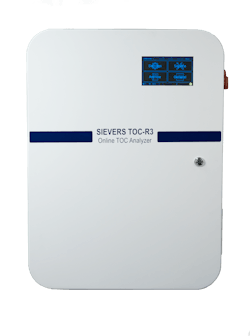Analytical equipment needs to be robust, reliable and responsive in order to detect change and enable corrective action. It also should be easy to use and provide high uptime.
When considering process organics monitoring, there’s a lot to unpack. To help make sense of all the capabilities, Chemical Processing spoke with Amanda Tyndall, senior product manager at Veolia Water Technologies and Solutions.
Q: Why is process monitoring important?
A: Monitoring industrial process water and wastewater is critical for process control, quality assurance, asset protection as well as regulatory compliance. Water is used in processes, it's used in a lot of products, and there's always wastewater generated that needs to be cleaned up before environmental discharge or potential onsite reuse. Process monitoring helps identify contamination, either from the source water or from process fluids. On the wastewater side, there are discharge guidelines to meet as well as many companies now having sustainability targets to reduce their water footprint. Ultimately, process monitoring aims to maintain productivity and avoid downtime while trying to help maximize revenue and minimize costs.
Q: What are some of the current pain points with process organics monitoring, and how can they be overcome?
A: The goals of process monitoring are first to establish a baseline, detect a change from that baseline and then take corrective action. When a user can't accurately set a baseline or pick up that deviation, there's no ability to take data-driven action.
One of the biggest challenges is when users can't detect what they're looking for, so they are unable to determine root cause of the contamination event.
You could make a decision on a hunch, but that adds risk. If that decision wasn't right because the data were unreliable, then it's hard to justify the action and resulting monetary expense. Either they cannot detect it because the technology isn't able to capture the change, or the instrument faces complex and lengthy maintenance so it’s not operating correctly.
This is the other big process-monitoring pain point, high maintenance and complex processes that drive up cost of ownership and drive down instrument uptime. Modern analytical instruments often have modular designs making it easy to maintain, troubleshoot and get back online if there is any issue.
There are several considerations that can help decision-making on process instrumentation. These include analysis time, complexity of technology, reagents or consumables needed, maintenance, ease of troubleshooting, moving parts that could fail, data management, automated features and diagnostics. These last three have really allowed users to be more hands-off, trust their data, and make data-driven process improvements.
Q: There are different TOC analyzers out there – how do they differ?
A: Total organic carbon (TOC) has been proven to be a critical tool for process monitoring; it's a direct way to measure complete organic contamination. While many discharge permits for wastewater are still written for historical biological oxygen demand (BOD) and chemical oxygen demand (COD), these measurements take two to three hours for COD with often hazardous reagents, and BOD takes five days. Those also can suffer from interferences that are common in water streams, like nitrates, chlorides, sulfides and disinfectants.
All TOC analyzers oxidize organics in the sample to carbon dioxide and then measure that carbon dioxide. They differ in the oxidation technique and the detection technique depending on what the stream is monitoring.
For oxidation, common technologies include UV light, UV light with an oxidizing agent, heat with an oxidizing agent, combustion at different temperatures and with or without catalysts, two-staged advanced oxidation and supercritical water oxidation involving pressure and temperature. These are listed in order of increasing sample complexity. For pure streams, UV light can oxidize the small amount of organics present. For complex streams with salts and solids, supercritical water oxidation, two staged advanced oxidation and combustion are designed for those harsher conditions.
For detection, pure samples use direct conductivity or membrane conductivity measuring CO2 in liquid, while more complex samples use non-dispersive infrared detection of CO2 in the gas form. There are pros and cons to each of these, and the goal is to match the proper technology with the desired application and water quality monitoring goals. It is important to consider the goals, whether speed, accuracy, robustness, complete carbon, etc.
For pure samples, the goal of monitoring is really to measure nothing. They want to search for no contaminants in the water. Here accuracy, precision and stability are driving factors. The technology is generally simple because it's looking for very small amounts of contamination.
For process, utility and even source water, TOC technologies aim to capture all the organics to determine quality levels and detect leaks. For source water, this includes natural organics matter like humic acids. For food & beverage, TOC would include proteins, sugars or starches. For utility water, key organic contaminants are glycol or other cooling fluids that could breakdown to form organics acids and cause corrosion. The goal is to provide robust and responsive operation to fully capture and continuously monitor processes for quality and control.
Finally, for wastewater, where the sample is more complex, the analyzer must be fit for more rigorous demands like salts, solids and high organics loading. Additional applications in chemical processing and refining could require operation in a hazardous environment where data is critical to process continuity and plant safety. In these cases, automated features like rinsing, calibration and predictive diagnostics help provide uptime and simple troubleshooting to stay in compliance and optimize treatment processes. Additional data management tools now allow businesses to drive processes off data and trend data over time to enable efficiencies. Having not only the data handy but also the instrument performance, maintenance cycles, calibration checks, help drive increased uptime and analytical performance.
Q: Do they stand up to the harsh environments you just suggested?
A: They do if they're built right for the application; for example, a pure water analyzer wouldn’t handle a wastewater stream. When we think about harsh environments and complex streams, combustion has been an industry staple for organics monitoring. There are, however, different types of combustion at different temperatures and with varying oxidation aids. Catalytic combustion uses a platinum catalyst where the catalyst efficiency can vary with organic compounds and catalyst activity diminishes as active sites fill up. Catalytic combustion is used both in the lab and online, but sometimes needs more frequent calibrations and exchange of the catalyst to provide trustworthy data at the target range.
On the contrary, high-temperature, non-catalytic combustion offers full complete oxidation of tough samples that can be relied upon for comprehensive organics analysis. This simple technology makes it easier for operators to trust data and avoid unnecessary downtime from maintenance or consumables replacements. Without the need for excess reagents, this high-temperature non-catalytic combustion avoids the need for bringing hazardous chemicals onsite that other technologies may require.
Q: What are the main applications, and are there other uses?
A: Organics analysis helps municipalities and industrial users track water quality, control treatment processes and maintain regulatory or corporate compliance. Common applications include tracking organics removal from source water to point of use, whether as an ingredient, boiler feedwater, condensate return or cleaning as examples.
Oftentimes, industries are looking to maintain productivity, maximize profitability and protect assets within the facility, whether those are equipment assets like boilers and condensing treatment or whether they're water treatment equipment like biological systems or membranes. Protecting these equipment assets from fouling through proper pretreatment or rapidly and sensitively detecting leaks can prevent downtime, repairs, early replacement, and even plant shutdown.
A growing application is from users thinking about overall water footprint and finding opportunity to reuse. Following water from source through treatment to use then instead of discharging treated wastewater, process monitoring can indicate if a stream is able to be reused. Each of these points must meet a quality target, and they're not all the same.
Q: Anything that you would like to add?
A: When we think about what's changing and how we can overcome these pain points, some exciting developments are around automation features and predictive diagnostics. These features help prevent downtime, lower maintenance requirements and provide trustworthy data. Automation features can include check standards, calibration and rinsing, which helps with those challenging samples. Status monitoring of what's going on inside the analyzer provides usage information and health of the analyzer.
We want to design instrumentation with robustness, reliability and responsiveness to establish a baseline, detect a change and make corrective actions. An analyzer with high uptime, simple operation and low maintenance helps operators optimize treatment processes, maximize profitability and find opportunities for sustainability.
For more information, visit: www.veoliawatertechnologies.com

